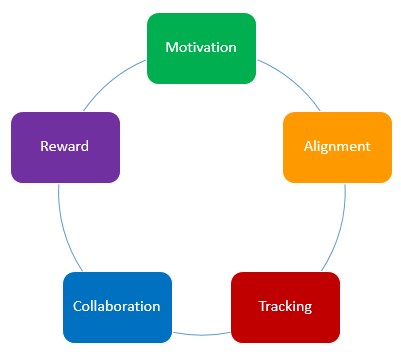Employee Performance Goals
Most organizations create goals for each individual employee. These goals describe the employee’s top priorities for the upcoming year. Typically, these goals describe important job responsibilities and what key performance outcomes the employees should be attempting to achieve.
These individual goals are designed to help the organization as a whole meet their strategic goals. It is easier to reach the organization’s goals if all the employees’ goals are linked and in sync with what the organization wants to achieve.
Benefits of Employee Performance Goals
There are several benefits of having Employee Performance Goals including:
- Provides clear direction to employees
- Clarifies the specific expectations of the management
- Clearly indicates success measurements
- Helps motivate employees
- Cultivates a strong sense of accomplishment and fulfillment when goals are achieved.
SMART Goals
Effective performance goals helps employee understand what the measurable successful achievement is for their goal and how it will play into the organization as a whole. Creating SMART is a best practice for many organizations.
SMART is an acronym used to effectively set goals. It is a simple tool to help create an actionable plan that gets results. A SMART goal should be specific, measurable, achievable, relevant, and time-bound.
S – Specific
M – Measurable
A – Achievable
R – Relevant
T – Time-bound
Keys to Employee Performance Goals
Certain key elements should be addressed when creating a goal system for employees. These elements will help ensure the success of the program.
Motivation
Highly-motivated individuals have a willingness to get the job done efficiently and effectively. This willingness results in benefits for the company including higher productivity, increased revenue, and cost savings.
An employee motivation can be increased by setting well-defined, challenging, but achievable goals. By successfully achieving specific goals and objectives, employees develop a sense of accomplishment and pride. This feeling encourages them to keep looking forward to new accomplishments, and thus in turn increasing their performance levels.
However, it is important to keep in mind, well written goals alone do not increase motivation. An organization must have a positive environment. The organization’s culture and working atmosphere must be positive in order to raise motivation and performance levels.
Strategic Alignment
Connecting the strategic goals of an organization to each of the employee’s performance goals is critical to the success of an organization. In an effectively aligned organization, everyone is working towards the same goal. Each individual knows exactly how their job tasks contribute to the success of the overall organization. With everyone working together toward the same objectives, the company can efficiently execute their strategy.
To achieve goal alignment in an organization, the strategic goals and objectives must first be clearly communicated across the entire company. These strategic goals are tied to the company’s mission and vision statements. These goals determine the desired results of an organization and how those results will be achieved. After the organizational goals and objectives are set, goals are then are broken down across the organizational hierarchy eventually reaching individual employees.
Encourage Participation
Employees respond much better to goal setting if they have participated in the process. Therefore, the process should be a collaborative effort between an employee and his or her supervisor or manager. Having employees actively involved in identifying and creating his or her goals increases ownership of their objectives along with the chance of successful achievement. It also allows them to better understand how their individual goals fit with the objectives of the organization.
Tracking and Monitor Progress
It is important to track the progress on goals throughout the year. This ensures that people are on target to achieve their goals. Therefore, a monitoring system should be put in place to ensure the goals are on track to be accomplished in the time required.
Since the goals are SMART, they are measurable and time-bound. This allows for measurements at various intervals so that issues can be dealt with before they threaten goal achievement.
Reward Performance
Everyone likes to be rewarded for a job they have done well. Hence, in order for a goal system to be effective, a reward system must be in place. Goal achievement should be tied to a reward and recognition such as increased compensation. Therefore, when an employee achieves his or her SMART goal at the end of the year, they should receive a raise computable to the level of achievement. Essentially, it gives incentives to achieving the goal.
Aligning Organizational Goals Employee Goals

